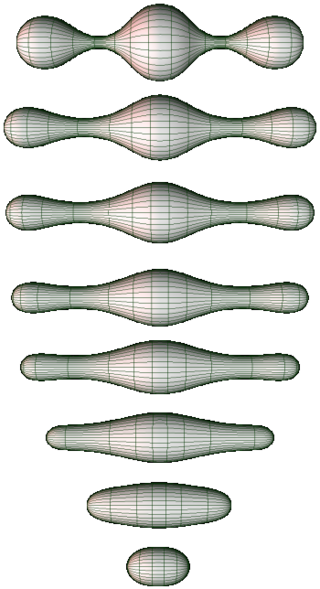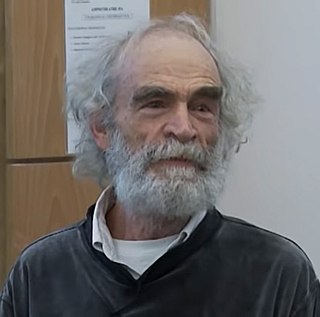
In the mathematical fields of differential geometry and geometric analysis, the Ricci flow, sometimes also referred to as Hamilton's Ricci flow, is a certain partial differential equation for a Riemannian metric. It is often said to be analogous to the diffusion of heat and the heat equation, due to formal similarities in the mathematical structure of the equation. However, it is nonlinear and exhibits many phenomena not present in the study of the heat equation.

Shing-Tung Yau is a Chinese-American mathematician and the William Caspar Graustein Professor of Mathematics at Harvard University. In April 2022, Yau announced retirement from Harvard to become Chair Professor of mathematics at Tsinghua University.

Richard Streit Hamilton is an American mathematician who serves as the Davies Professor of Mathematics at Columbia University. He is known for contributions to geometric analysis and partial differential equations. Hamilton is best known for foundational contributions to the theory of the Ricci flow and the development of a corresponding program of techniques and ideas for resolving the Poincaré conjecture and geometrization conjecture in the field of geometric topology. Grigori Perelman built upon Hamilton's results to prove the conjectures, and was awarded a Millennium Prize for his work. However, Perelman declined the award, regarding Hamilton's contribution as being equal to his own.

Mikhael Leonidovich Gromov is a Russian-French mathematician known for his work in geometry, analysis and group theory. He is a permanent member of Institut des Hautes Études Scientifiques in France and a professor of mathematics at New York University.
In the mathematical field of differential geometry, there are various splitting theorems on when a pseudo-Riemannian manifold can be given as a metric product. The best-known is the Cheeger–Gromoll splitting theorem for Riemannian manifolds, although there has also been research into splitting of Lorentzian manifolds.
In mathematics, the soul theorem is a theorem of Riemannian geometry that largely reduces the study of complete manifolds of non-negative sectional curvature to that of the compact case. Jeff Cheeger and Detlef Gromoll proved the theorem in 1972 by generalizing a 1969 result of Gromoll and Wolfgang Meyer. The related soul conjecture, formulated by Cheeger and Gromoll at that time, was proved twenty years later by Grigori Perelman.

Richard Melvin Schoen is an American mathematician known for his work in differential geometry and geometric analysis. He is best known for the resolution of the Yamabe problem in 1984.

Shiu-Yuen Cheng (鄭紹遠) is a Hong Kong mathematician. He is currently the Chair Professor of Mathematics at the Hong Kong University of Science and Technology. Cheng received his Ph.D. in 1974, under the supervision of Shiing-Shen Chern, from University of California at Berkeley. Cheng then spent some years as a post-doctoral fellow and assistant professor at Princeton University and the State University of New York at Stony Brook. Then he became a full professor at University of California at Los Angeles. Cheng chaired the Mathematics departments of both the Chinese University of Hong Kong and the Hong Kong University of Science and Technology in the 1990s. In 2004, he became the Dean of Science at HKUST. In 2012, he became a fellow of the American Mathematical Society.
In the mathematical field of differential geometry, a smooth map between Riemannian manifolds is called harmonic if its coordinate representatives satisfy a certain nonlinear partial differential equation. This partial differential equation for a mapping also arises as the Euler-Lagrange equation of a functional called the Dirichlet energy. As such, the theory of harmonic maps contains both the theory of unit-speed geodesics in Riemannian geometry and the theory of harmonic functions.

Thierry Aubin was a French mathematician who worked at the Centre de Mathématiques de Jussieu, and was a leading expert on Riemannian geometry and non-linear partial differential equations. His fundamental contributions to the theory of the Yamabe equation led, in conjunction with results of Trudinger and Schoen, to a proof of the Yamabe Conjecture: every compact Riemannian manifold can be conformally rescaled to produce a manifold of constant scalar curvature. Along with Yau, he also showed that Kähler manifolds with negative first Chern classes always admit Kähler–Einstein metrics, a result closely related to the Calabi conjecture. The latter result, established by Yau, provides the largest class of known examples of compact Einstein manifolds. Aubin was the first mathematician to propose the Cartan–Hadamard conjecture.
The Geometry Festival is an annual mathematics conference held in the United States.

Robert "Bob" Osserman was an American mathematician who worked in geometry. He is specially remembered for his work on the theory of minimal surfaces.

Leon Melvyn Simon, born in 1945, is a Leroy P. Steele Prize and Bôcher Prize-winning mathematician, known for deep contributions to the fields of geometric analysis, geometric measure theory, and partial differential equations. He is currently Professor Emeritus in the Mathematics Department at Stanford University.
In Riemannian geometry, a field of mathematics, Preissmann's theorem is a statement that restricts the possible topology of a negatively curved compact Riemannian manifold. It is named for Alexandre Preissmann, who published a proof in 1943.

Gerhard Huisken is a German mathematician whose research concerns differential geometry and partial differential equations. He is known for foundational contributions to the theory of the mean curvature flow, including Huisken's monotonicity formula, which is named after him. With Tom Ilmanen, he proved a version of the Riemannian Penrose inequality, which is a special case of the more general Penrose conjecture in general relativity.
In mathematics, the Almgren–Pitts min-max theory is an analogue of Morse theory for hypersurfaces.
David Allen Hoffman is an American mathematician whose research concerns differential geometry. He is an adjunct professor at Stanford University. In 1985, together with William Meeks, he proved that Costa's surface was embedded. He is a fellow of the American Mathematical Society since 2018, for "contributions to differential geometry, particularly minimal surface theory, and for pioneering the use of computer graphics as an aid to research." He was awarded the Chauvenet Prize in 1990 for his expository article "The Computer-Aided Discovery of New Embedded Minimal Surfaces". He obtained his Ph.D. from Stanford University in 1971 under the supervision of Robert Osserman.
Peter Wai-Kwong Li is a mathematician whose research interests include differential geometry and partial differential equations, in particular geometric analysis. After undergraduate work at California State University, Fresno, he received his Ph.D. at University of California, Berkeley under Shiing-Shen Chern in 1979. Presently he is Professor Emeritus at University of California, Irvine, where he has been located since 1991.
Joel Spruck is a mathematician, J. J. Sylvester Professor of Mathematics at Johns Hopkins University, whose research concerns geometric analysis and elliptic partial differential equations. He obtained his PhD from Stanford University with the supervision of Robert S. Finn in 1971.
Joseph Harold Sampson Jr. was an American mathematician known for his work in mathematical analysis, geometry and topology, especially his work about harmonic maps in collaboration with James Eells. He obtained his Ph.D. in mathematics from Princeton University in 1951 under the supervision of Salomon Bochner.










